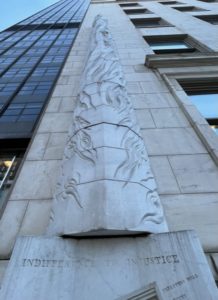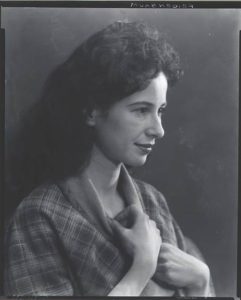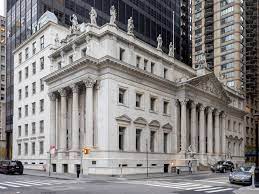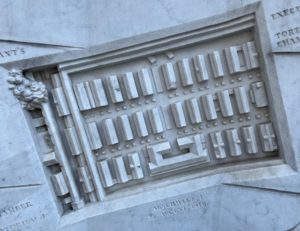Spring Can Be Hell – Reflections on the “Memorial to All Victims of the Holocaust 1938-1945”, the Insight and Foresight of Harriet Feigenbaum, and the Limits of Tolerance and Tragedy
This article is part of RPJ’s non-legal series about the neighborhood and city we inhabit and love, and is a timely contribution both celebrating Women’s History Month and denouncing the invasion of Ukraine.
 Growing up, working and residing in or around the Flatiron area of New York City, has meant that at least twice on most days, I pass the Holocaust Memorial attached to the Appellate Division Supreme Court of New York State located on the corner of 25th Street and Madison Avenue. The Memorial’s inscription, “INDIFFERENCE TO INJUSTICE IS THE GATE TO HELL,” provides daily inspiration to our law firm colleagues concerning who we aspire to be and what we strive to do. The purpose and history behind this Memorial continue to be urgent every day – and its disturbing back-story uniquely relevant today, as well as ironic given the history of the liberation of Auschwitz, Poland, by the Russian Ukrainian Forces.
Growing up, working and residing in or around the Flatiron area of New York City, has meant that at least twice on most days, I pass the Holocaust Memorial attached to the Appellate Division Supreme Court of New York State located on the corner of 25th Street and Madison Avenue. The Memorial’s inscription, “INDIFFERENCE TO INJUSTICE IS THE GATE TO HELL,” provides daily inspiration to our law firm colleagues concerning who we aspire to be and what we strive to do. The purpose and history behind this Memorial continue to be urgent every day – and its disturbing back-story uniquely relevant today, as well as ironic given the history of the liberation of Auschwitz, Poland, by the Russian Ukrainian Forces.
The Context
The “Memorial to All Victims of the Holocaust 1938-1945” was commissioned in the 1980s by the Organization for the Memorial to Victims of the Injustice of the Holocaust and sponsored by New York City’s Department of Citywide Administrative Services with the assistance of the Department of Cultural Affairs. It is reported that, in 1987, the Appellate Division’s Presiding Justice Francis Murphy and attorney David Finkelstein were engaged in meaningful discussion of “indifference towards injustice” and “the talk just leaned towards [indifference to] injustice being the cause of the Holocaust.”[1] “The fact is that indifference continued for so long it created the Holocaust,” was Finkelstein’s view.[2] The discussion prompted Justice Murphy to assemble a team of consultants to consider the idea of a privately funded Holocaust memorial for the Appellate Division Courthouse—which ultimately would be the first of its kind to grace any U.S. public building.[3]
The Artist

More than 60 artists reportedly applied for the monument commission, from which five were selected to create presentations. Ultimately, New York artist and sculptor Harriet Feigenbaum was selected.[4] Feigenbaum herself is Jewish and had been born in 1939 at the outset of World War II. Justice Murphy and Harold J. Reynolds, the Clerk of the Court, are credited with having conceived of the inscription, “INDIFFERENCE TO INJUSTICE IS THE GATE TO HELL.”[5]
For Feigenbaum’s proposal of a memorial, she studied “photographs of the death houses and a rendering of the main camp at Auschwitz in Poland, drawn by a prison inmate in 1944.”[6] Feigenbaum drew gradually closer to her subject: the hovering chimney of what appeared to be an innocuous warehouse, but what masked the gas chamber.” Id. ”I tried to isolate what the Holocaust was in the chimney and in the building where 1,000 people could be slaughtered every 15 minutes,” she said. Id. ”The monument will start at basement level with the chimney rising from the flames and being consumed by flames ultimately.” Id.
It bears noting that Auschwitz was liberated not by the Americans but by the Russian forces, and in particular by the Ukrainian Force, comprised from many regions of Russia and in particular with soldiers and commanders from the Ukraine.[7] Indeed, a Ukrainian tank commander, Ihor Pobirchenko, is credited with plowing open the gates of Auschwitz to liberate the camp, although that account is a matter of some dispute.[8] This is one of many historic factors being discussed behind Poland’s current support of Ukraine.
The Prescient Sculpture
Feigenbaum’s tall marble sculpture runs vertically along the northwestern corner of the Appellate Division Courthouse, originally constructed in the 1890s, opened in 1899, and expanded and modernized after World War II, with its annex opened in 1954.[9] Designed at the height of the Beaux-arts movement by James Brown Lord in 1896, the original Courthouse is adorned along its roof and entrance with marble sculptures of notable men in the history of law including Moses, Lycurgus, and Solon.[10] Yet, it is the female artist and sculptor Harriet Feigenbaum whose work is at eye-level, and resonates urgently today. Created a full 35 years after the annex was opened in 1954, the Holocaust Memorial was unveiled in 1990, the first Holocaust memorial of its kind on any U.S. public building.[11]

The Ironic History of the Image
This small but intensely powerful monument depicts an aerial relief of the main concentration camp at Auschwitz, Poland. At first glance, the Memorial appears to be an architectural rendering. However the story is much more complex – and disturbing. Specific functions at Auschwitz are identified around the marble frieze: Torture Chamber, Execution Wall, Gas Chamber and Crematorium 1, and the Commandant’s House adjacent to it all. Above the three-dimensional rectangular model of the camp rises a dramatic plume of smoke and flame, carved into the marble 38 feet high. The angry swirls recall the gas chambers and incineration of bodies at the Nazi death camps, and appear to bow and blow toward the Courthouse, suggesting the fraility of justice in the face of human nature. The flames reach from below, arising from the pit of the sculpture a full story beneath ground, a reminder of the Crematorium.

Feigenbaum traveled to Querceta, Italy, to design and craft the monument from the same type of Carrara marble that reportedly had been used to build the Appellate Division Courthouse.[12] But the material had another dimension: “Streaks of gray in the marble will create the illusion of smoke” from the Crematorium, Ms. Feigenbaum said when planning the sculpture.[13]
The Indifferent Photograph
The source of the image Feigenbaum chose to use for her sculpture is reported to be a photograph of Auschwitz taken during an Allied bombing raid on August 25, 1944, by the 15th U.S. Army Air Force.[14] The United States Government reportedly did not acknowledge the existence of Auschwitz until much later. Id. Some of the factories that the planes were bombing were less than five miles from the Auschwitz gas chambers. Id. Additional such raids took place in September 1944, December 1944, and January 1945. George S. McGovern, the future U.S. Senator and Democratic presidential nominee, was a pilot on one of the raids.[15]
“Feigenbaum’s choice of source material is used to question the moral character of the Allies, who, by the taking the photo itself, exhibit their awareness of the camp existence, and their simultaneous indifference to addressing that very existence,” writes Nasha Virita at Untapped Cities. “INDIFFERENCE TO INJUSTICE” is carved above the aerial image of Auschwitz, the artist suggesting the aerial photograph itself demonstrated indifference to injustice. “IS THE GATE TO HELL” is inscribed below the image of the death camp and above the deep well representing the Crematorium. By the selection of this particular photograph as the model for her work, Feigenbaum is conveying through her visual artistry how the Allies must have known of the camp on the date she inscribed in stone – August 25, 1944. The U.S. planes had the ability to bomb at least portions of the camp, yet took no action and failed to liberate the camp, which was not liberated for five more months, on January 27, 1945 – by the Russians.[16]
The Memorial to All Victims of the Holocaust 1938-1945 is a painful reminder of the daily death and destruction being inflicted by Russia on the people of Ukraine—whose soldiers were in part responsible for the liberation of Auschwitz. Today, capable nations face complex decisions and constraints on direct intervention due to adhesive treaties, partisan politics, every-day economics, or fear of escalation of the war into World War III. In an interview, Feigenbaum explained her intent behind the Memorial: “I want people to be drawn to the sculpture and to want to discover what the Holocaust was–the methodical method of murder, the horror that was Auschwitz.”[17] Feigenbaum’s message commemorating the atrocities committed in a war that engulfed the world over 80 years ago, serves as a continued daily reminder to us now that “Indifference to Injustice is the Gate to Hell.” And it’s only getting warmer.

This article is intended as a general discussion of these issues only and is not to be considered legal advice or relied upon. For more information, please contact RPJ Partner Helen D. “Heidi” Reavis who counsels clients in areas of corporate operations and brand management, employment matters and dispute resolution, and media and intellectual property law.
[1] “Discover Flatiron: Memorial to Victims of the Injustice of the Holocaust.” Flatiron 23rd Street Partnership, March 30, 2021. Discover Flatiron: Memorial to Victims of the Injustice of the Holocaust (flatirondistrict.nyc)
[2] “Discover Flatiron: Memorial to Victims of the Injustice of the Holocaust.” Flatiron 23rd Street Partnership, March 30, 2021. Discover Flatiron: Memorial to Victims of the Injustice of the Holocaust (flatirondistrict.nyc)
[3] “Discover Flatiron: Memorial to Victims of the Injustice of the Holocaust.” Flatiron 23rd Street Partnership, March 30, 2021. Discover Flatiron: Memorial to Victims of the Injustice of the Holocaust (flatirondistrict.nyc)
[4] Nasha Virata, “A Hidden Holocaust Memorial on NYC’s Appellate Division Court in the Flatiron.” Untapped New York. A Hidden Holocaust Memorial on NYC’s Appellate Division Court in the Flatiron (untappedcities.com)
[5] Cecilia Cummings, “A Memorial to Holocaust is Approved.” The New York Times, July 27, 1988. A Memorial to Holocaust is Approved – The New York Times (nytimes.com)
[6] Cecilia Cummings, “A Memorial to Holocaust is Approved.” The New York Times, July 27, 1988. A Memorial to Holocaust is Approved – The New York Times (nytimes.com)
[7] Luke J. Spencer, “The Hidden Holocaust Memorial of Madison Park.” Atlas Obscura, December 10, 2014. The Hidden Holocaust Memorial of Madison Park (atlasobscura.com); Erin Blakemore, “The Shocking Liberation of Auschwitz: Soviets ‘Knew Nothing’ as They Approached.” History, January 27, 2021. The Shocking Liberation of Auschwitz: Soviets ‘Knew Nothing’ as They Approached (history.com)
[8] Serhiy Hrabovsky, “Ukraine and Auschwitz: History and Politics.” Euromaidan Press, January 27, 2015. Ukraine and Auschwitz: History and Politics (euromaidanpress.com)
[9] “Appellate Division Courthouse of New York State.” Wikipedia. Appellate Division Courthouse of New York State (wikipedia.org)
[10] Luke J. Spencer, “The Hidden Holocaust Memorial of Madison Park.” Atlas Obscura, December 10, 2014. The Hidden Holocaust Memorial of Madison Park (atlasobscura.com)
[11]“Discover Flatiron: Memorial to Victims of the Injustice of the Holocaust.” Flatiron 23rd Street Partnership, March 30, 2021. Discover Flatiron: Memorial to Victims of the Injustice of the Holocaust (flatirondistrict.nyc)
[12] Cecilia Cummings, “A Memorial to Holocaust is Approved.” The New York Times, July 27, 1988. A Memorial to Holocaust is Approved – The New York Times (nytimes.com)
[13] Cecilia Cummings, “A Memorial to Holocaust is Approved.” The New York Times, July 27, 1988. A Memorial to Holocaust is Approved – The New York Times (nytimes.com)
[14] “Memorial to Victims of the Injustice of the Holocaust.” Wikipedia. Memorial to Victims of the Injustice of the Holocaust (wikipedia.org); “Discover Flatiron: Memorial to Victims of the Injustice of the Holocaust.” Flatiron 23rd Street Partnership, March 30, 2021. Discover Flatiron: Memorial to Victims of the Injustice of the Holocaust (flatirondistrict.nyc)
[15] “Memorial to Victims of the Injustice of the Holocaust.” Wikipedia. Memorial to Victims of the Injustice of the Holocaust (wikipedia.org)
[16] “Memorial to Victims of the Injustice of the Holocaust.” Wikipedia. Memorial to Victims of the Injustice of the Holocaust (wikipedia.org); Erin Blakemore, “The Shocking Liberation of Auschwitz: Soviets ‘Knew Nothing’ as They Approached.” History, January 27, 2021. The Shocking Liberation of Auschwitz: Soviets ‘Knew Nothing’ as They Approached (history.com)
[17] Nasha Virata, “A Hidden Holocaust Memorial on NYC’s Appellate Division Court in the Flatiron.” Untapped New York. A Hidden Holocaust Memorial on NYC’s Appellate Division Court in the Flatiron (untappedcities.com)
